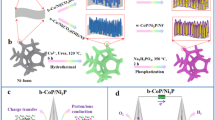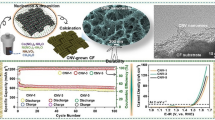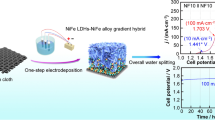Abstract
Nonprecious metal-based oxygen reduction reaction (ORR) electrocatalysts with high efficiency in both alkaline and acidic media are being intensively studied for the purpose of replacing expensive Pt-based catalysts; however, it is still a challenge to achieve superior ORR performances, especially in acidic media. Herein, by pyrolysis of mixed precursors of diammonium phosphate, melamine and hemin, we prepared a nanocomposite catalyst (denoted as FeP@PGL) composed of nitrogen-doped carbon nanosheets with embedded FeP nanoparticles (NPs), which were encapsulated by in-situ formed phosphorus-doped graphene layers. It is found that phosphorous was preferentially doped in the coating layers on FeP NPs, instead of in the carbon nanosheets. The FeP@PGL catalyst exhibited excellent ORR performance, with the onset and half-wave potential up to 1.01 and 0.90 V vs. the reversible hydrogen electrode (RHE) in alkaline media, and 0.95 and 0.81 V vs. RHE in acidic media, respectively. By thorough microscopy and spectroscopy characterizations, the interfacial charge transfer between the encapsulated FeP NPs and P-doped graphene layers was identified, and the local work function of the catalyst surface was also reduced by the interfacial interaction. The interfacial synergy between the encapsulated FeP and phosphorus-doped graphene layers was essential to enhance the ORR performance. This study not only demonstrates the promising ORR properties of the encapsulated-FeP-based nanocomposite catalyst, but also provides direct evidence of the interfacial charge transfer effect and its role in ORR process.
摘要
开发高效的非贵金属氧还原反应(ORR)催化剂来替代铂基 催化剂受到了广泛关注. 设计合成在碱性电解质和酸性电解质中 均表现出高催化活性的非贵金属催化剂仍然是一个挑战. 在本文 中, 我们通过前驱体热解法制备了一种纳米复合催化剂 (FeP@PGL), 该催化剂由氮掺杂的碳纳米片以及镶嵌在片层上的 磷掺杂石墨烯层封装磷化铁(FeP)纳米颗粒组成. FeP@PGL催化剂 表现出优异的ORR催化性能, 在碱性介质中的起始电位和半波电 势分别高达1.01 V 和0.90 V vs. RHE; 在酸性介质中的起始电位和 半波电势分别高达0.95 V和0.81 V vs. RHE. 通过详细的电子显微和 谱学表征, 我们发现碳纳米片基质与包裹纳米颗粒的碳包裹层存 在组成的差别, 磷掺杂主要发生在包裹FeP纳米颗粒的石墨烯层上. 封装的FeP纳米颗粒与外层磷掺杂石墨烯层之间存在界面电荷转 移, 并且通过界面相互作用降低了催化剂表面的功函数. FeP和磷 掺杂石墨烯层之间的界面协同作用对于增强催化剂ORR活性至关 重要. 本文不仅证明了封装型FeP基纳米复合催化剂在氧还原反应 上的应用价值, 而且为界面电荷转移效应及其在ORR过程中的作 用提供了实验证据.
Similar content being viewed by others
References
Chen Z, Higgins D, Yu A, et al. A review on non-precious metal electrocatalysts for PEM fuel cells. Energy Environ Sci, 2011, 4: 3167–3192
Jaouen F, Proietti E, Lefèvre M, et al. Recent advances in non-precious metal catalysis for oxygen-reduction reaction in polymer electrolyte fuelcells. Energy Environ Sci, 2011, 4: 114–130
Nie Y, Li L, Wei Z. Recent advancements in Pt and Pt-free catalysts for oxygen reduction reaction. Chem Soc Rev, 2015, 44: 2168–2201
Shao M, Chang Q, Dodelet JP, et al. Recent advances in electrocatalysts for oxygen reduction reaction. Chem Rev, 2016, 116: 3594–3657
Spendelow JS, Papageorgopoulos DC. Progress in PEMFC MEA component R&D at the DOE fuel cell technologies program. Fuel Cells, 2011, 11: 775–786
Wu G, Zelenay P. Nanostructured nonprecious metal catalysts for oxygen reduction reaction. Acc Chem Res, 2013, 46: 1878–1889
Dai L, Xue Y, Qu L, et al. Metal-free catalysts for oxygen reduction reaction. Chem Rev, 2015, 115: 4823–4892
Hang C, Zhang J, Zhu J, et al. In situ exfoliating and generating active sites on graphene nanosheets strongly coupled with carbon fiber toward self-standing bifunctional cathode for rechargeable Zn-air batteries. Adv Energy Mater, 2018, 8: 1703539
Zhang J, Sun Y, Zhu J, et al. Defect and pyridinic nitrogen engineering of carbon-based metal-free nanomaterial toward oxygen reduction. Nano Energy, 2018, 52: 307–314
Gewirth AA, Varnell JA, DiAscro AM. Nonprecious metal catalysts for oxygen reduction in heterogeneous aqueous systems. Chem Rev, 2018, 118: 2313–2339
Wang W, Jia Q, Mukerjee S, et al. Recent insights into the oxygen-reduction electrocatalysis of Fe/N/C materials. ACS Catal, 2019, 9: 10126–10141
Cheng Y, He S, Lu S, et al. Iron single atoms on graphene as nonprecious metal catalysts for high-temperature polymer electrolyte membrane fuel cells. Adv Sci, 2019, 6: 1802066
Ye W, Chen S, Lin Y, et al. Precisely tuning the number of Fe atoms in clusters on N-doped carbon toward acidic oxygen reduction reaction. Chem, 2019, 5: 2865–2878
Ni B, Wu L, Chen R, et al. Fe/Co-based nanoparticles encapsulated in heteroatom-doped carbon electrocatalysts for oxygen reduction reaction. Sci China Mater, 2019, 62: 1626–1641
Tan H, Li Y, Kim J, et al. Sub-50 nm iron-nitrogen-doped hollow carbon sphere-encapsulated iron carbide nanoparticles as efficient oxygen reduction catalysts. Adv Sci, 2018, 5: 1800120
Jiang WJ, Gu L, Li L, et al. Understanding the high activity of Fe−N−C electrocatalysts in oxygen reduction: Fe/Fe3C nanoparticles boost the activity of Fe−Nx. J Am Chem Soc, 2016, 138: 3570–3578
Hu Y, Jensen JO, Zhang W, et al. Hollow spheres of iron carbide nanoparticles encased in graphitic layers as oxygen reduction catalysts. Angew Chem Int Ed, 2014, 53: 3675–3679
Wu ZY, Xu XX, Hu BC, et al. Iron carbide nanoparticles encapsulated in mesoporous Fe-N-doped carbon nanofibers for efficient electrocatalysis. Angew Chem Int Ed, 2015, 54: 8179–8183
Li Z, Wei L, Jiang WJ, et al. Chemical state of surrounding iron species affects the activity of Fe−Nx for electrocatalytic oxygen reduction. Appl Catal B-Environ, 2019, 251: 240–246
Deng D, Yu L, Chen X, et al. Iron encapsulated within pod-like carbon nanotubes for oxygen reduction reaction. Angew Chem Int Ed, 2013, 52: 371–375
Liu X, Liu H, Chen C, et al. Fe2N nanoparticles boosting FeNx moieties for highly efficient oxygen reduction reaction in Fe−N−C porous catalyst. Nano Res, 2019, 12: 1651–1657
Zhang J, He D, Su H, et al. Porous polyaniline-derived FeNxC/C catalysts with high activity and stability towards oxygen reduction reaction using ferric chloride both as an oxidant and iron source. J Mater Chem A, 2014, 2: 1242–1246
Xu X, Shi C, Chen R, et al. Iron phosphide nanocrystals decorated in situ on heteroatom-doped mesoporous carbon nanosheets used for an efficient oxygen reduction reaction in both alkaline and acidic media. RSC Adv, 2017, 7: 22263–22269
Zhang R, Zhang C, Chen W. FeP embedded in N, P dual-doped porous carbon nanosheets: an efficient and durable bifunctional catalyst for oxygen reduction and evolution reactions. J Mater Chem A, 2016, 4: 18723–18729
Hu K, Xiao Z, Cheng Y, et al. Iron phosphide/N, P-doped carbon nanosheets as highly efficient electrocatalysts for oxygen reduction reaction over the whole pH range. Electrochim Acta, 2017, 254: 280–286
Fan X, Kong F, Kong A, et al. Covalent porphyrin framework-derived Fe2P@Fe4N-coupled nanoparticles embedded in N-doped carbons as efficient trifunctional electrocatalysts. ACS Appl Mater Interfaces, 2017, 9: 32840–32850
Long C, Li X, Guo J, et al. Electrochemical reduction of CO2 over heterogeneous catalysts in aqueous solution: recent progress and perspectives. Small Methods, 2018, 3: 1800369
Yang F, Aba dia M, Chen C, et al. Design of active and stable oxygen reduction reaction catalysts by embedding CoxOy nanoparticles into nitrogen-doped carbon. Nano Res, 2016, 10: 97–107
Wang Z, Li B, Ge X, et al. Co@Co3O4@PPD core@bishell nanoparticle-based composite as an efficient electrocatalyst for oxygen reduction reaction. Small, 2016, 12: 2580–2587
Mahmood J, Li F, Kim C, et al. Fe@C2N: A highly-efficient indirect-contact oxygen reduction catalyst. Nano Energy, 2018, 44: 304–310
Zhang X, Lin J, Chen S, et al. Co nanoparticles encapsulated in N-doped carbon nanosheets: enhancing oxygen reduction catalysis without metal-nitrogen bonding. ACS Appl Mater Interfaces, 2017, 9: 38499–38506
Pandiyan R, Oulad Elhmaidi Z, Sekkat Z, et al. Reconstructing the energy band electronic structure of pulsed laser deposited CZTS thin films intended for solar cell absorber applications. Appl Surf Sci, 2017, 396: 1562–1570
Yuan H, Hou Y, Wen Z, et al. Porous carbon nanosheets codoped with nitrogen and sulfur for oxygen reduction reaction in microbial fuel cells. ACS Appl Mater Interfaces, 2015, 7: 18672–18678
Wei W, Liang H, Parvez K, et al. Nitrogen-doped carbon nanosheets with size-defined mesopores as highly efficient metal-free catalyst for the oxygen reduction reaction. Angew Chem Int Ed, 2014, 53: 1570–1574
Liang HW, Zhuang X, Brüller S, et al. Hierarchically porous carbons with optimized nitrogen doping as highly active electrocatalysts for oxygen reduction. Nat Commun, 2014, 5: 4973
Wang X, Ma W, Xu Z, et al. Metal phosphide catalysts anchored on metal-caged graphitic carbon towards efficient and durable hydrogen evolution electrocatalysis. Nano Energy, 2018, 48: 500–509
Yang DS, Bhattacharjya D, Inamdar S, et al. Phosphorus-doped ordered mesoporous carbons with different lengths as efficient metal-free electrocatalysts for oxygen reduction reaction in alkaline media. J Am Chem Soc, 2012, 134: 16127–16130
Yu Y, Peng Z, Asif M, et al. FeP nanocrystals embedded in N-doped carbon nanosheets for efficient electrocatalytic hydrogen generation over a broad pH range. ACS Sustain Chem Eng, 2018, 6: 11587–11594
Li R, Wei Z, Gou X. Nitrogen and phosphorus dual-doped graphene/carbon nanosheets as bifunctional electrocatalysts for oxygen reduction and evolution. ACS Catal, 2015, 5: 4133–4142
Ahn SH, Yu X, Manthiram A. “Wiring” Fe−Nx-embedded porous carbon framework onto 1D nanotubes for efficient oxygen reduction reaction in alkaline and acidic media. Adv Mater, 2017, 29: 1606534
Huang Z, Pan H, Yang W, et al. In situ self-template synthesis of Fe-N-doped double-shelled hollow carbon microspheres for oxygen reduction reaction. ACS Nano, 2018, 12: 208–216
Kong A, Zhu X, Han Z, et al. Ordered hierarchically micro- and mesoporous Fe−Nx-embedded graphitic architectures as efficient electrocatalysts for oxygen reduction reaction. ACS Catal, 2014, 4: 1793–1800
Jiang P, Liu Q, Liang Y, et al. A cost-effective 3D hydrogen evolution cathode with high catalytic activity: FeP nanowire array as the active phase. Angew Chem Int Ed, 2014, 53: 12855–12859
Zhang Z, Lu B, Hao J, et al. FeP nanoparticles grown on graphene sheets as highly active non-precious-metal electrocatalysts for hydrogen evolution reaction. Chem Commun, 2014, 50: 11554–11557
Zheng Y, Cheng P, Xu J, et al. MOF-derived nitrogen-doped nanoporous carbon for electroreduction of CO2 to CO: the calcining temperature effect and the mechanism. Nanoscale, 2019, 11: 4911–4917
Yang HB, Miao J, Hung SF, et al. Identification of catalytic sites for oxygen reduction and oxygen evolution in N-doped graphene materials: Development of highly efficient metal-free bifunctional electrocatalyst. Sci Adv, 2016, 2: e1501122
Lyu Y, Wang R, Tao L, et al. tIn-situ evolution of active layers on commercial stainless steel for stable water splitting. Appl Catal B-Environ, 2019, 248: 277–285
Li X, Liu W, Zhang M, et al. Strong metal-phosphide interactions in core-shell geometry for enhanced electrocatalysis. Nano Lett, 2017, 17: 2057–2063
Lee DH, Lee WJ, Lee WJ, et al. Theory, synthesis, and oxygen reduction catalysis of Fe-porphyrin-like carbon nanotube. Phys Rev Lett, 2011, 106: 175502
Liang Y, Li Y, Wang H, et al. Co3O4 nanocrystals on graphene as a synergistic catalyst for oxygen reduction reaction. Nat Mater, 2011, 10: 780–786
Zhao Y, Wan J, Yao H, et al. Few-layer graphdiyne doped with sp-hybridized nitrogen atoms at acetylenic sites for oxygen reduction electrocatalysis. Nat Chem, 2018, 10: 924–931
Han J, An P, Liu S, et al. Reordering d orbital energies of single-site catalysts for CO2 electroreduction. Angew Chem Int Ed, 2019, 58: 12711–12716
Long C, Wang K, Shi Y, et al. Tuning the electronic structure of PtRu bimetallic nanoparticles for promoting the hydrogen oxidation reaction in alkaline media. Inorg Chem Front, 2019, 6: 2900–2905
Acknowledgements
This work was supported by the National Natural Science Foundation of China (21773128, 21534005, and 21421001).
Author information
Authors and Affiliations
Contributions
Ni B, Chen R and Wu L conducted the experiments. All authors contributed to experimental design, data analysis and interpretation. Ni B and Chen T wrote the manuscript.
Corresponding author
Additional information
Conflict of interest
The authors declare no competing financial interests.
Supplementary information
Experimental details and supporting data are available in the online version of the paper.
Baoxia Ni received her PhD degree from Nankai University in 2020. Her research focuses on the design and synthesis of nanostructured carbon electrocatalysts.
Tiehong Chen received his BSc and PhD degrees from Nankai University in 1990 and 1996, respectively. He joined Nankai University in 1996. He is currently a professor at the School of Materials Science and Engineering. His current research interests include the syntheses of zeolites and mesoporous materials, heterogeneous catalysis and electrocatalysis.
Supplementary Information
40843_2020_1525_MOESM1_ESM.pdf
Encapsulated FeP nanoparticles with in-situ formed P-doped graphene layers: Boosting activity in oxygen reduction reaction
Rights and permissions
About this article
Cite this article
Ni, B., Chen, R., Wu, L. et al. Encapsulated FeP nanoparticles with in-situ formed P-doped graphene layers: Boosting activity in oxygen reduction reaction. Sci. China Mater. 64, 1159–1172 (2021). https://doi.org/10.1007/s40843-020-1525-7
Received:
Accepted:
Published:
Issue Date:
DOI: https://doi.org/10.1007/s40843-020-1525-7




